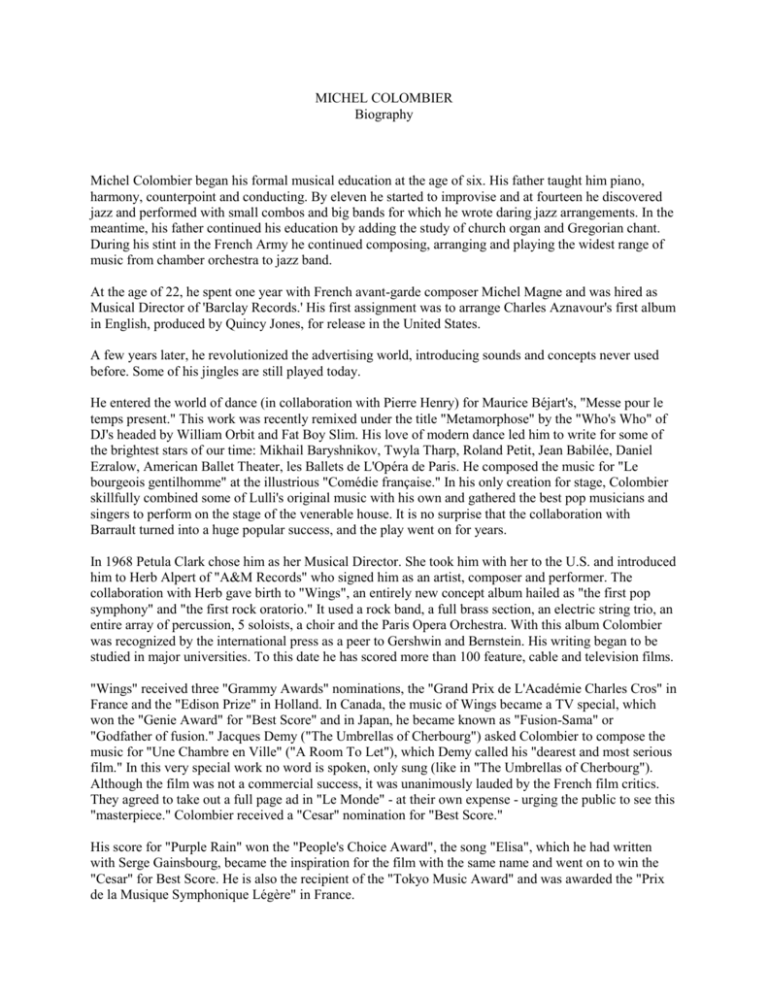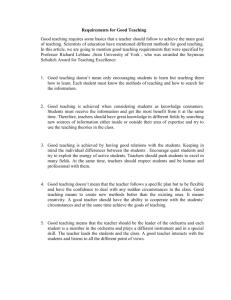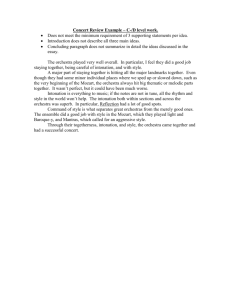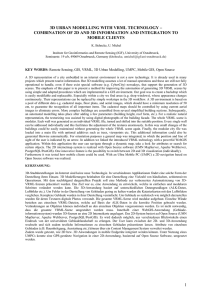Biography - Michel Colombier
advertisement

MICHEL COLOMBIER Biography Michel Colombier began his formal musical education at the age of six. His father taught him piano, harmony, counterpoint and conducting. By eleven he started to improvise and at fourteen he discovered jazz and performed with small combos and big bands for which he wrote daring jazz arrangements. In the meantime, his father continued his education by adding the study of church organ and Gregorian chant. During his stint in the French Army he continued composing, arranging and playing the widest range of music from chamber orchestra to jazz band. At the age of 22, he spent one year with French avant-garde composer Michel Magne and was hired as Musical Director of 'Barclay Records.' His first assignment was to arrange Charles Aznavour's first album in English, produced by Quincy Jones, for release in the United States. A few years later, he revolutionized the advertising world, introducing sounds and concepts never used before. Some of his jingles are still played today. He entered the world of dance (in collaboration with Pierre Henry) for Maurice Béjart's, "Messe pour le temps present." This work was recently remixed under the title "Metamorphose" by the "Who's Who" of DJ's headed by William Orbit and Fat Boy Slim. His love of modern dance led him to write for some of the brightest stars of our time: Mikhail Baryshnikov, Twyla Tharp, Roland Petit, Jean Babilée, Daniel Ezralow, American Ballet Theater, les Ballets de L'Opéra de Paris. He composed the music for "Le bourgeois gentilhomme" at the illustrious "Comédie française." In his only creation for stage, Colombier skillfully combined some of Lulli's original music with his own and gathered the best pop musicians and singers to perform on the stage of the venerable house. It is no surprise that the collaboration with Barrault turned into a huge popular success, and the play went on for years. In 1968 Petula Clark chose him as her Musical Director. She took him with her to the U.S. and introduced him to Herb Alpert of "A&M Records" who signed him as an artist, composer and performer. The collaboration with Herb gave birth to "Wings", an entirely new concept album hailed as "the first pop symphony" and "the first rock oratorio." It used a rock band, a full brass section, an electric string trio, an entire array of percussion, 5 soloists, a choir and the Paris Opera Orchestra. With this album Colombier was recognized by the international press as a peer to Gershwin and Bernstein. His writing began to be studied in major universities. To this date he has scored more than 100 feature, cable and television films. "Wings" received three "Grammy Awards" nominations, the "Grand Prix de L'Académie Charles Cros" in France and the "Edison Prize" in Holland. In Canada, the music of Wings became a TV special, which won the "Genie Award" for "Best Score" and in Japan, he became known as "Fusion-Sama" or "Godfather of fusion." Jacques Demy ("The Umbrellas of Cherbourg") asked Colombier to compose the music for "Une Chambre en Ville" ("A Room To Let"), which Demy called his "dearest and most serious film." In this very special work no word is spoken, only sung (like in "The Umbrellas of Cherbourg"). Although the film was not a commercial success, it was unanimously lauded by the French film critics. They agreed to take out a full page ad in "Le Monde" - at their own expense - urging the public to see this "masterpiece." Colombier received a "Cesar" nomination for "Best Score." His score for "Purple Rain" won the "People's Choice Award", the song "Elisa", which he had written with Serge Gainsbourg, became the inspiration for the film with the same name and went on to win the "Cesar" for Best Score. He is also the recipient of the "Tokyo Music Award" and was awarded the "Prix de la Musique Symphonique Légère" in France. The artist Folon has created several watercolors inspired by Michel Colombier's music, including the main title of a French television station (Antenne 2) for which he used the haunting oboe solo from Wings, entitled Emmanuel. The Folon Foundation, due open in September 2000 in Belgium, will feature Colombier's music throughout the museum while visitors will discover Folon's dearest works. He has written numerous ballets, songs, chamber music, symphonic works, four concertos and four "video operas." He has worked with an extremely diversified array of artists: Madonna, Kronos Quartet, Jaco Pastorius, Prince, Herb Alpert, Supertramp, Petula Clark, Roberta Flack, Barbra Streisand, Johny Mathis, Charles Trenet, the Beach Boys, Branford Marsalis, Herbie Hancock, Bill Withers, Joni Mitchell, Jean-Pierre Rampal, Earth Wind & Fire, Stéphane Grappelli, the Canadian Brass, Charles Aznavour, Ernie Watts, Flora Purim & Airto, Serge Gainsbourg, Barbara, Folon, the London Symphony Orchestra, the English Chamber Orchestra, the Los Angeles Philharmonic, the Los Angeles Chamber Orchestra and the Paris Opéra. [For Michel Colombier’s detailed discography, please visit: http://www.michelcolombier.com]










